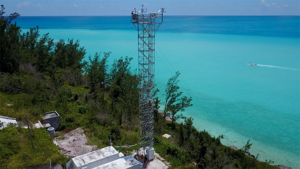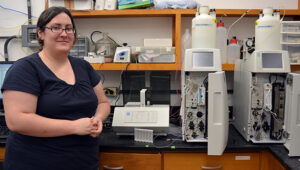Where the Sea Meets the Sky

The Tudor Hill Marine Atmospheric Observatory overlooks the ocean in Southampton, Bermuda.
Nestled between the 75 vertical miles (120 kilometers) of Earth’s atmosphere and the deepest point of the ocean is a strip of air called the planetary boundary layer. This region, located in the lower troposphere (the lowest portion of the atmosphere, up to six miles, or 10 kilometers, in altitude), is where friction from the earth’s surface influences temperature, moisture, and wind.
This layer, known as the PBL, plays an important role in Earth’s weather and climate systems, continuously changing thickness and temperature to adjust for the heating and cooling of the planet’s surface. In doing so, the PBL creates currents of air that transport heat and condense water vapor into droplets that eventually form clouds, which scatter sunlight and impact rates of photosynthesis on the surface below. The PBL also influences the ocean down to depths of around 300 feet (100 meters), as winds set surface waters in motion and drive far-reaching ocean currents that distribute heat, transport nutrients, and define marine environments.
Given these significant impacts, it is unsurprising that a specialized field of science has emerged to study the complex interactions between the earth, ocean, and atmosphere. Research within ocean-atmosphere science covers a broad spectrum of topics, but fundamentally seeks to understand the physical and chemical processes that occur in both the ocean and atmosphere, and how they influence each other.
For the last thirty years, the BIOS Tudor Hill Marine Atmospheric Observatory has been making year-round measurements of the atmosphere over the ocean. The facility, comprising a 75-foot (23 meter) aluminum tower outfitted with an array of sampling instrumentation, is one of only a handful that exist worldwide that is not based on a ship or buoy mooring. Due to its remote geographic location, the facility has emerged as an international site for long-term study of atmospheric transport of aerosols and gases in the North Atlantic.
With support from the National Science Foundation (NSF) since 2003, BIOS has been operating the observatory as a site for both focused research and routine activities, including the collection of meteorological data, weekly airborne particulate sampling, and weekly rainwater sampling. As part of ongoing international collaborations, the observatory has also made measurements of persistent organic pollutants, ozone, and carbon dioxide concentrations in the lower atmosphere, as well as air column properties.
Over its three decades of operation, the observatory has supported a number of interns, students participating in the NSF-funded Research Experience for Undergraduates program, and even doctoral and postdoctoral scholars, making it important not just to the science community, but to students and emerging researchers as well.

Caroline White worked in the BIOS Air Quality Laboratory for 12 weeks last fall conducting an investigation into aerosols found in Bermuda’s atmosphere.
Last fall, Caroline White, a doctoral student in biogeochemical science at the University of Plymouth in England was funded by the U.K. Associates of BIOS to work with Andrew Peters, lead scientist for the Tudor Hill observatory and the newly appointed director of university programs. Beginning in mid-September, White spent 12 weeks investigating the organic nitrogen compounds in aerosols, or minute suspended particles, within the atmosphere surrounding Bermuda.
Aerosols can be naturally occurring, such as ash from volcanoes and mineral dust from deserts, or from human-made sources, such as sulfate aerosols from the burning of coal and oil. Their presence in the atmosphere can have a significant impact on Earth’s climate system, as the particles can both absorb sunlight (which warms the atmosphere around them and impacts cloud formation) and scatter sunlight (which reduces the amount of sunlight traveling to Earth’s surface). Aerosols can also act as sites for chemical reactions, including some that lead to the creation of chlorine, which destroys ozone in the atmosphere.
“The aerosol sampling equipment at the University of Plymouth was built based on the design of the Tudor Hill instruments, so it has been an amazing opportunity to see the original machines, learn about them, and use them to collect data for my research,” White said.
